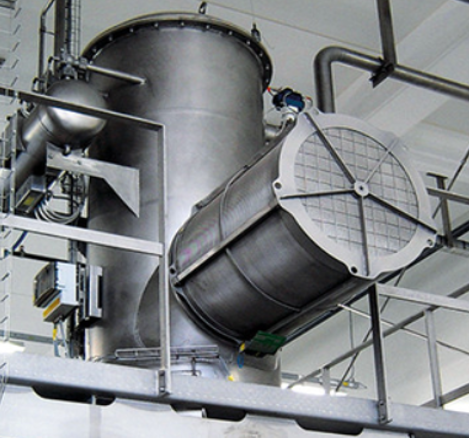
atmospheric oxygen
Image on the left: Pressure relief device from Rembe.
Atmospheric oxygen is a colourless and odourless gas that makes up approximately 20.95 per cent of the Earth's atmosphere. The chemical composition of the air remains almost constant at high altitudes, but air density and total pressure decrease with increasing distance from the Earth's surface. At an altitude of approximately 20 kilometres, the atmospheric pressure is only about 0.055 bar instead of 1.013 bar at sea level. Oxygen is essential for aerobic organisms, as it serves as an electron acceptor in cellular respiration.
Oxygen is highly reactive and promotes oxidative chemical reactions. These processes lead to corrosion of metals, rancidity of fatty foods, changes in smell and taste, and loss of quality in chemical and pharmaceutical products. Oxidation reactions are often autocatalytic. Temperature, humidity, light and pH significantly accelerate these processes.
Powdered bulk solids have a large specific surface area, which increases significantly as particle size decreases. They usually exist as a two-phase system consisting of solid particles and enclosed air. This gas phase is found both in the spaces between the particles and in the pores of individual grains. This makes bulk solids particularly sensitive to oxygen.
Oxidation can be reduced by replacing the existing air with an inert gas. This process is called inerting. Nitrogen or argon displace the oxygen from process rooms, apparatus or packaging. Nitrogen is the most commonly used gas due to its availability and cost. Technical options include purging, vacuum flooding, underflushing or process atmospheres with overpressure. This slows down or completely prevents oxidative reactions.
Fine powders can pose an increased risk of explosion in powder mixers, as oxygen is a component of combustible dust-air mixtures. For this reason, amixon® mixers operate at low speeds and are designed in accordance with the ATEX directive. The devices are vacuum-resistant, so that the gas phase in the mixing chamber can be largely evacuated and then replaced by an inert protective gas. This significantly reduces the risk of explosion and increases product safety. amixon® mixers can also be manufactured to be pressure-resistant or pressure-shock-resistant.
Protective gas atmospheres are often used in packaging technology to extend the shelf life of sensitive products. Packaging machines generate a controlled nitrogen atmosphere that reduces the oxygen content of the surrounding gas phase and prevents quality deterioration. This process is known as "modified atmosphere packaging".
